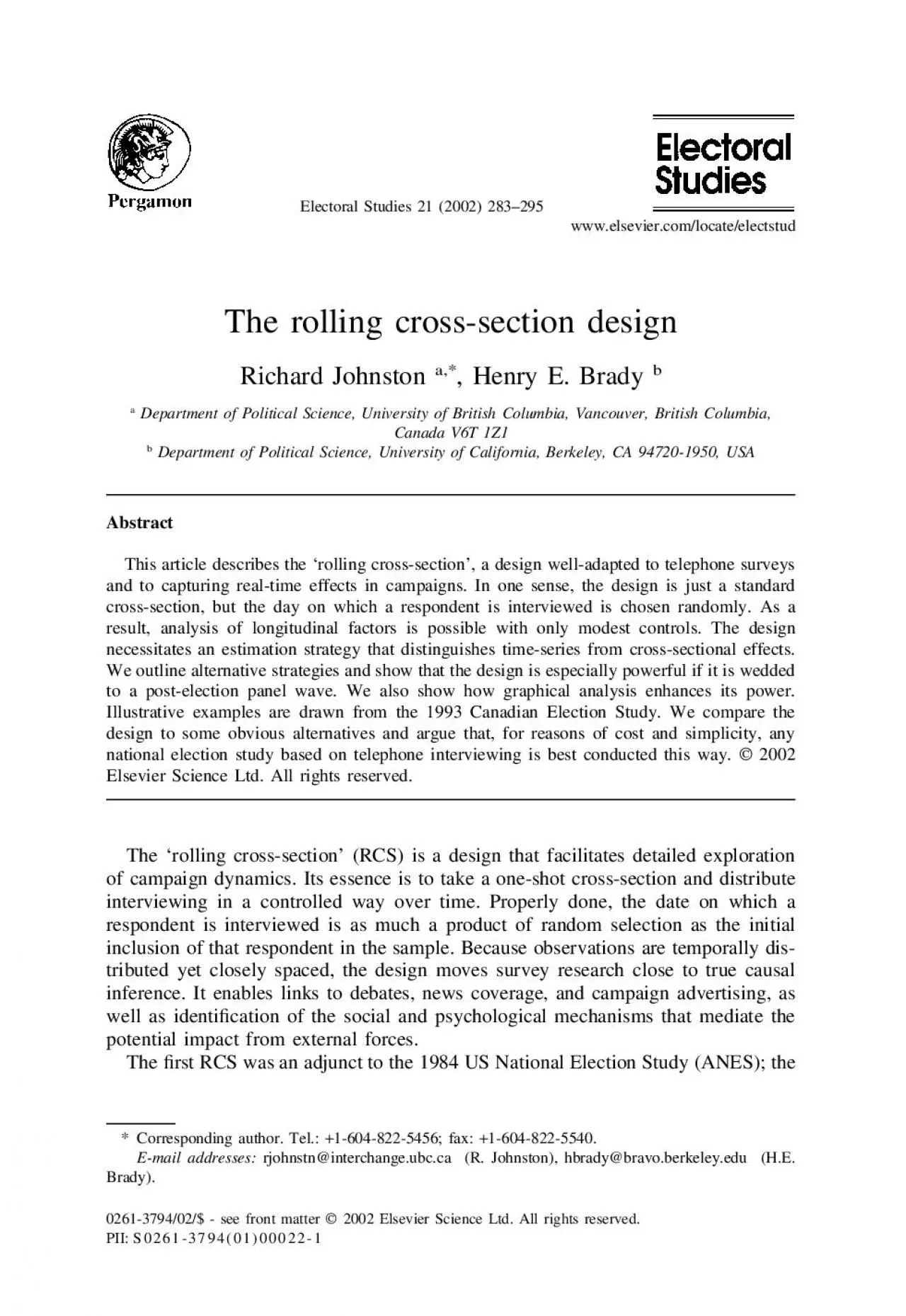

TherollingcrosssectiondesignRichardJohnstonaHenryEBradyDepartmentofPoliticalScienceUniversityofBritishColumbiaVancouverBritishColumbiaCanadaV6T1Z1DepartmentofPoliticalScienceUniversityofCali ID: 941762
Download Pdf The PPT/PDF document "ElectoralStudies212002283295" is the property of its rightful owner. Permission is granted to download and print the materials on this web site for personal, non-commercial use only, and to display it on your personal computer provided you do not modify the materials and that you retain all copyright notices contained in the materials. By downloading content from our website, you accept the terms of this agreement.
ElectoralStudies21(2002)283295 Therollingcross-sectiondesignRichardJohnstona,*,HenryE.BradyDepartmentofPoliticalScience,UniversityofBritishColumbia,Vancouver,BritishColumbia,CanadaV6T1Z1DepartmentofPoliticalScience,UniversityofCalifornia,Berkeley,CA94720-1950,USA Thisarticledescribestherollingcross-section,adesignwell-adaptedtotelephonesurveysandtocapturingreal-timeeffectsincampaigns.Inonesense,thedesignisjustastandardcross-section,butthedayonwhicharespondentisinterviewedischosenrandomly.Asaresult,analysisoflongitudinalfactorsispossiblewithonlymodestcontrols.Thedesignnecessitatesanestimationstrategythatdistinguishestime-seriesfromcross-sectionaleffects.Weoutlinealternativestrategiesandshowthatthedesignisespeciallypowerfulifitisweddedtoapost-electionpanelwave.Wealsoshowhowgraphicalanalysisenhancesitspower.Illustrativeexamplesaredrawnfromthe1993CanadianElectionStudy.Wecomparethedesigntosomeobviousalternativesandarguethat,forreasonsofcostandsimplicity,anynationalelectionstudybasedontelephoneinterviewingisbestconductedthisway.ElsevierScienceLtd.Allrightsreserved. Therollingcross-section(RCS)isadesignthatfacilitatesdetailedexplorationofcampaigndynamics.Itsessenceistotakeaone-shotcross-sectionanddistributeinterviewinginacontrolledwayovertime.Properlydone,thedateonwhicharespondentisinterviewedisasmuchaproductofrandomselectionastheinitialinclusionofthatrespondentinthesample.Becauseobservationsaretemporallydis-tributedyetcloselyspaced,thedesignmovessurveyresearchclosetotruecausalinference.Itenableslinkstodebates,newscoverage,andcampaignadvertising,aswellasidenti cationofthesocialandpsychologicalmechanismsthatmediatethepotentialimpactfromexternalforces.The rstRCSwasanadjuncttothe1984USNationalElectionStudy(ANES);the *Correspondingauthor.Tel.:1-604-822-5456;fax:E-mailaddresses:rjohnstn@interchange.ubc.ca(R.Johnston),hbrady@bravo.berkeley.edu(H.E.0261-3794/02/$-seefrontmatter2002ElsevierScienceLtd.Allrightsreserved.PII:S0261-3794(01)00022-1 R.Johnston,H.E.Brady/ElectoralStudies21(2002)283295secondwasthe198788USsuperTuesdayprimarystudy.Thedesignscomingofage,however,wast
he1988CanadianElectionStudy(CES).Thisstudyanditssuccessorsin19923and1997,havebeenintenselyminedfortheirdynamicproper-ties,andcampaigneffectshavebecome,arguably,theCESsabidingtheme.Canadianexamplewasfollowedinthe1996NewZealandElectionStudy,inthe1998ANESpilotstudy,andthemassiveYear2000studyattheAnnenbergSchoolforCommunication,UniversityofPennsylvania.Newformsofdatademandnewformsofanalysis.Parametersappearthathithertowerenotidentiable.RCSdatarequireandalsorepayintensegraphicaltreat-ment.Indeed,informal,nonparametric,visualanalysisisoftennecessarypriortoformal,statisticaleffort.Thispaperillustratesthesepropositionsbyshowinghowvoteintentionsevolveoveracampaign,bypresentingalternativestatisticalmodelstohelpexplainvotedynamics,andbyshowinghowgraphicalanalysishelpstoresolvetheremainingexplanatoryuncertainties.First,however,whatarolling1.BasicelementsofthedesignInitself,conductingatelephonesurveyasarollingcross-sectionisunremarkable.Allpollswithstretched-outeldworkharbortemporalheterogeneity.Iftheseproper-tiesareacknowledged,itismainlyasaproblem,becausethoseinterviewedlaterusuallydifferinimportantwaysfromthoseinterviewedearlier.Forthe1988Cana-dianteam,theconceptualbreakthroughwastoseetheneedforprotractedsampleclearancenotasaproblem,butasanopportunity.Bybeingself-consciousaboutreleaseandclearanceofthesample,wecouldconverttemporalheterogeneityintoanobjectofstudy.Arollingcross-sectiondesignusingatelephonesurveyrequires,rst,abodyoftelephonenumberssufcientlylargetoyieldatargetnumberofinterviews.Thisbodyisthenbrokenupinto.IntheCEScase,onereplicateisgeneratedforeachdayofprojectedinterviewing.Eachreplicateisaminiatureofthetotal,inthatassignmenttoareplicateisessentiallyrandom,justasinitialselectionforthetotalsampleisrandom.TheCESgoesintotheeldwithindaysofthestartoftheelectioncampaign,but,inprinciple,eldworkcanstartatanytime.Althougheachdayhasitsreplicate,thereplicateitselfisnottheproperunitfor The1984datawereairedinBradyandJohnston(1987)andBartels(1987,1988).The1988SuperTuesdaydata,however,seemtoliefallow.See,inparticular,Johnstonetal.(1992,1994,1996)andNevitteetal.(2000).SeeVowle
setal.(1998),especiallych.5(Johnston)andch.8(Miller).Co-investigatorsontheYear2000StudyareJohnstonandKathleenHallJamieson.Therstpubli-cationbasedonthisstudyisHagenetal.(2000).Nothingrequiresthatonlyonereplicateisissuedperday.TheAnnenbergYear2000study,forinstance,variedtheoverallintensityandthegeographicfocusofeldworkaccordingtotheyearselectoralrhythms.TheRCSresponseratemodeldifferssubtlyfromotherdesigns,asshownbelow. R.Johnston,H.E.Brady/ElectoralStudies21(2002)283representingcampaigntime.Thiswouldimplythatallnumbersinagivenreplicateremainopenforcontactbyinterviewersononedayonly.Thisisobviouslybadsurveypractice,asonlytheeasiesttoreachwouldbecontacted.Fig.1(A)prothelag,forthe1993Canadiandata,betweenthereleaseofatelephonenumbertosampleandactualcompletionofaninterviewatthatnumber.Fromthetypicalrepli-cate,almosthalftheinterviewsareultimatelycompletedonthedayofrelease.Anotherone-sixtharecompletedthenextday,one-twelfth,thedayafterthat,andsoon.Themedianlagis1dayandthemeanlagis2.1days.Five-sixthsoftheinterviewsthatwilleverbecompletedfromareplicatearecompletedin5days,includingthereleaseday.Theremainingone-sixthisdistributedthinlyoversuc-ceedingdays,andvirtuallyallarecompletedinside2weeks. Fig.1.Distributionofinterviews. R.Johnston,H.E.Brady/ElectoralStudies21(2002)283Thedistributionofcompletedinterviewsbyeldworkdayinthe1993studyisshowninFig.1(B).Days13arequalitativelydifferentfromallthatfollow,inthattherewerefewerthan50completions.Byday4,completionsclear80perday,roughlythedailyaveragefromthenon.Itisatthispointthatthedayofinterviewbecomes,effectively,arandomevent.Onlyattheveryenddoesanythingbeyondstochasticerrorappear.Thelastdaystakeexceeds120,overone-thirdgreaterthanusual.Thisreectsprospectiverespondentsrealizationthatthereisnotomorrow;aninterviewcannotbescheduledforanotherday.Critically,nointensicationofeffortoccursinthisperiod,andtheintegrityofthedesignrequiresthattherebenosuchintensication.Otherwise,thedateofinter-viewwouldnotbearandomevent(and,frankly,itisnotatthebeginningandnotquiteonthelastday).Thisdoesmean,however,thattheoverallresponserateforanRCSwillbelowerthanfo
ralesstime-consciousdesign.Stableclearanceeffortnecessarilyimpliesthatlatereplicateswillnotbeexhaustedascompletelyasearlierones.Totalcompletionsdonotag,asFig.1(B)makesclear,butonlybecauseearlierreplicatesarenallyseeingtheirtardymemberscleared.Completionsfromlatereplicatesbegintodropwith2weekstogo,aswewouldexpectfromdiscussion,above,ofFig.1(A).Inthesecondlastweek,thedropisverygradual,fromadailycompletionrateinthemid-80stooneinthemid-70s.Inthelastweek,thedropisprecipitate,tothe60sandthenbelow50onthelastday.Hadwebeenabletocontinueclearingreplicatesafterelectionday,theresponseratecouldhavebeenaboutthreepercentagepointshigher.Hadwereleasedtelephonenumberstosampleasquicklyashousecapacityallowedandbegunaggressiveclearanceearly,wemighthavegainedstillmorerespondents.ButthenwewouldnothavehadarollingWhatdowegetwhenwegetarollingcross-section?Fig.2(A)showshowadynamicanalysismightstart.Ittracksoneofthecriticalquantitiesofthe1993campaign:theshareofvoteintentionsaccruingtothegoverningConservativeParty.Thejaggedlineisthedailyshareandthesmoothlineisthe7-daymovingaverageofthatshare.Earlyon,theConservativeshareisinthemid-30s,veryclosetotheshare(notpresented)foritschiefrival,theLiberalParty.Betweeneldworkdays11and13,accordingtothemovingaveragetracking,theConservativePartysharedroppednearlytenpoints,andbyday15therecouldbenodoubtthatthepartyhadlostatleastthatmuch.Thedailytrackingis,ofcourse,highlyvariabledaytoday,butithintsthatthiscollapserequiredonly2days.Itplungedapartytheninpowerintoaghtforitsverylife.Subsequenteventsadmitcontraryreadings.Ononereading,thebalanceofthecampaignisjustthegradualplayingoutoftheinitialshock.Onanother,thatshockplaysoutwithindays,suchthattheConservativesharenowoscillatesata Quebecrespondentsareexcluded,ascampaigndynamicsinthatprovincewereweakerandsubtlydifferentfromelsewhere.Inthetypicalday,Quebecdwellersconstitutedabout25%ofthetotalsample,sothedailyreadingsinFig.2restonjustover60respondents. R.Johnston,H.E.Brady/ElectoralStudies21(2002)283 Fig.2.Conservativevote,Conservativeleader.Quebecrespondentsexcluded.newequilibrium,inthemid-20s.Onlyafterday34doesthesh
aretakeitsnaldive,alsoof10points. Weleantothesecondreading.Betweendays15and34,virtuallynotrendisvisible.Theeyemaybeledtoseeone,butthat,wesubmit,isavisualtrickplayedbythelast10days.Asigntestonthemiddle20daysyieldsasmanypositivesasnegativesonconsecutivedays.Afterday34virtuallyeverypairofdaysyieldsanegativechange.Thedropoverthis10-dayperiodisroughly10points,halfthetotalslide. R.Johnston,H.E.Brady/ElectoralStudies21(2002)2832.EstimatinglongitudinaleffectsClearly,somethinghappenedearlyinthecampaigntoupdatevotersbeliefsabouttheConservativeParty.Somethingelsemighthavehappenedlateinthecampaign,butthisismorecontestable.Howdowerepresenttheeffectofupdatedbeliefs?Assumeforthesakeofargumentthatwehaveonlyonerelevantbelief,beitaboutanissue,aleader,orastrategiccontingency.Consider,then,somebeliefattimeforpersonFortheeffectoftoberelatedtothecampaignproper,thepre-campaignlikelihoodofvotingforthepartymustbecontrolled.Thesimplestwaytodothisiswiththefollowingconditionalchangemodel:isthelikelihoodofpersonwhoiseventuallyinterviewedattimeforthepartyatthebeginningofthecampaign(Thecoeftheimpactof.Eq.(1)isessentiallythestandardmodelinthecampaign-effectsliterature(Finkel,1993,p.6;1995,pp.67),anditimpliesthatthelikelihoodatofpersonvotingfortheleaderisafunctionofthelikelihoodatthebeginningofthecampaignplustheeffectofthecurrentbeliefThelikelihoodofvotingforthepartybaseduponthepersonsbeliefbeforethecampaign,is:.(2)SubstitutingEq.(2)intoEq.(1)andcollectingtermsyieldsthefollowing:wherethecoefcientofinterestis.Wecansimplifythisbywriting:where,obviously:isthepersonsinitialbelief,andifisthebeliefatthetimeofinterview,thenthecoefseemslikeareasonabledenitionofacampaigneffect.Wecanthenestimatecampaigneffectsbyregressingvoteintentionatonbeliefsaswellasonbeliefsatthebeginningofthecampaign.Thisbringsustoanobviousproblem.IntheCanadianstudies,asintheother Ofcourse,nopersoninterviewedatonetimewithinthecampaignisinterviewedatanothersuchtime.Fornotationalsimplicity,weassumeanequalnumberofrespondentsforeachtimeperiod.Fig.1indicatesthatthisisnotquitetrue,butthatitisalmosttrueforallbuttheveryrstandtheverylastdays.
Thesubscriptrepresentsthecross-sectioninwhichtherespondentisinterviewedandisthatsidentierwithinthecross-section.IfthevariableismeasuredattheRCSinterview,thenwedonotaddasuperscript(henceandnot),butifitismeasuredatanothertime,say,inapre-electionbaseline,thenweaddthesuperscriptfortime,inthisexample, R.Johnston,H.E.Brady/ElectoralStudies21(2002)283RCSsamplesdrawnsofar,theRCSwaveisitselftherstone;thereisnopre-campaignbaseline.Itisnotevenclearthatwewantone,giventhatapre-campaigninterviewprimesrespondentsinwaysthatmakethecampaignwaveunrepresentative.Bethatasitmay,thisleavesuslackingdirectevidencefor.Itdoesnotsufjusttoenterintoanestimationof,asdoingsowouldconfoundlongitudinalwithcross-sectionalimpactbecauseofthecorrelationbetweenandtheomitted.Asageneralproposition,thereisnowaytoassesstheimpactofomittingbecausethereisnoreasontoassumeanyparticularcovariancebetweentime-seriesandcross-section.ThisisapointmadeforcefullybyKramer(1983),anditappliesnotjusttocampaignstudiessuchastheCESbutalsotoanyanalysisthatemploysthesamemeasuresinrepeatedsamples.JustasKramersproblemhasbeenaddressedelsewhere(Markus,1988),soitcanbeintheRCSdesign.Thisrequiresustoconsiderotherstartingplacesforestimation.Oneplacetolookelectionday,ifthedesignincludesapost-electionwave.TheotherplaceisinsidetheRCSitself,especiallyifpost-electioninformationisnotavailable.Ifkeymeasuresfromthecampaign-waveRCSarerepeatedpost-election,thenisobserved.Ifweallowourselvesastrongassumptionabouthowbeliefschange,wecansubstitute.Letusassumethatchangesasfollows:.(5)isthecross-sectionalstateofbeliefattimezeroandisthetime-seriesThisassumesthattodaysbeliefequalsthatatthebeginningofthecam-paignplussometime-serieseffectthatiscommonacrossallpeople.Everyoneopinion,then,isaffectedbythesameamount,,ateachtimeperiodWewishtoestimateEq.(4),anditcanbeestimatedifwehavevaluesfor.We,butwhatcanweusefor?IfEq.(5)iscorrect,then,apersonbeliefaftertheendofthecampaignasreportedonthepost-electioninterview,willbe:,(6)sothatdiffersfromonlyintheconstantanditwillbeperfectlycorre-latedwith.Consequently,wecansubstituteintoEq.(4)torepresenttheonlychangein(4)willbe
intheinterceptInreality,willnotbeperfectlycorrelated.Wecanimaginesomeobviouspossibilities:changesthatarerandom,uncorrelatedwithinitialbeliefs,assuggestedbytheliteraturesonnon-attitudesandonmeasurementerror;orchangethatissys-tematic,butcorrelatedwithoriginalbeliefs,asinopinioncrystallization.Thesetakeusbeyondthescopeofthispaper.Wenote,however,thatwheresuchchange standsfor,meaningvariationovertime.Thisassumptionisnotwarrantedbythefactsbutitisausefulstartingpoint,andspacedoesnotpermitfurtherconsiderationhere.BradyandJohnston(1996)discusstheconsequencesofrelaxingit. R.Johnston,H.E.Brady/ElectoralStudies21(2002)283andthusEq.(5)isunwarrantedisjustasinadequateasastartingpointasThefactstillremainsthatallvarianceinthepost-electionmeasureis,forourpurposes,cross-sectional:theelectionisoverandthefurorhasdiedimmediately;clearanceofthepost-electionsampleisrelativelyrapid;andinitiationofcontactisorthogonaltothedateofpre-electioninterview.Thus,thepost-electionreadingisareasonablestartingpointforseparatingcross-sectionalfromlongitudinaleffects.Whentakentogether,Eqs.(4)and(7)showthatthecoefcient()ontheRCSwavemeasure()indicatesthecampaigneffect,whilethecoefcient()onthepost-electionmeasureofbelief()measurestheresidualimpactofthebaselinebelief.Therestoftheimpactisin,andsothefullcross-sectionaleffectisindicatedby(Post-electionindicatorsarenotalwaysreadytohand.Neitherthe1984northe1988USRCShasapost-electionwave,andnotevenintheCESiseveryseriouscampaign-periodfactormeasuredtwice.Commonly,then,weareforcedtoconditiononday-to-dayinformation.Anobviousstartingpointistoaverageacrosstheeachdailysample:,(8)togetaquantitytorepresentthetime-serieseffectandtouse()torepresentthecross-sectionaleffect.Toseethattheseindicatorswilldothetrick,gobacktothelogicinEq.(5).Assumerst,formathematicalsimplicity,thatthepopulationmeanofissettozero,sothatwecanscaleThenifEq.(5)istruewecantakeaveragesonbothsidesovereachdailysampletoget:,(9)wherewehaveassumedthatthesamplemeanofiszerobecausethepopulationmeaniszero.(Thatis,weassumethatthesamplequantityisagoodapproxi-mationof,whichwillbetrueforlargedailysamples.)Withthisre
sult,wecanrearrangeEq.(5)togetanexpressionforintermsofobservablequantities:.(10)Ifwehavelargedailysamples,thenshouldbeclosetothetrueandtheestimateinEq.(10)shouldbeclosetotheactual.Hence,wecanregressandon()from(10).Thisprocedureshouldyieldaconsistentestimatorof AnintuitivestatementoftheserelationshipscanbefoundinJohnstonetal.(1992).AsomewhatformalelaborationcanbefoundinBradyandJohnston(1996),whereweweakentheassumptionsinEq.(5).Thisisaharmlessassumptionthat,operationally,onlyrequiresthatwecalculatethemean,andsubtractthisquantityfromall.Thisamounts,then,tosettingtozero. R.Johnston,H.E.Brady/ElectoralStudies21(2002)283campaigneffects.Toseethis,gobackagaintoEq.(4)andsubstitute()for.(11)cientshavethesameinterpretationasinEq.(7).Inprinciple,thisisaveryattractivestrategy.Thekeyphraseintheforegoing,however,islargedailysample.Thestatisticalconsistencythatmadetheestimatorsoattractiveaccruesasthesizeofthedailysamplesincreaseswithoutlimit.Tworelatedconsequencesofsmalldailysamplesoccurtous.First,thesamplingvarianceassociatedwith80completionsperdayintroducesextraerrorintoEq.(8)asanindicatorofthetruedailymean.Thispresentsuswithaclassicerrors-in-variablesproblem,whichcouldbiastowardszeroand,possibly,intheotherdirection.Second,totheextentthatismismeasured,variationinwillleakinto(),suchthatthetwowillbecollinear,inatingstandarderrorsonboth3.AnexampleTable1givesapracticalexample,byshowingtheimpactofleaderratingson1993Conservativevoteintention,estimatedeachway.Coefcientsareextractedfromalargerestimation,whichalsoincludespolicyandexpectationsvariables.Table1TheimpactofleaderratingsonConservativevote Conditioningon: LeaderIndividualinfopostDailymean 0.95***(0.06)1.05***(0.27)0.17**(0.06)0.08(0.27)0.60***(0.06)0.76*(0.38)0.25***(0.07)0.09(0.38)0.43***(0.06)0.71**(0.23)0.02(0.06)0.30(0.24)-adj0.370.30SEE0.360.3715011984 EstimationbyOLS.Standarderrorsinparentheses.*0.05;**0.01;*** Leaderratingsare100-pointthermometerscalescompressedtothe01interval.Acompletedescrip-tionofthevariablescanbefoundinBradyandJohnston(1996).Note,however,thattheestimationherevariesinsomeparticularsfromtheonereporte
dthere. R.Johnston,H.E.Brady/ElectoralStudies21(2002)283Thealternativesetupsprovidehighlysimilarestimationsoftotaltime-seriespluscross-sectionaleffect,butthedaily-meanversionassignsmoreofthetotaltothetimeseries.Notealsothatthedaily-meantime-seriescoefcients,althoughlarge,areunstable.Wesuspectthisreectstheartifactsjustdiscussed.Forallthat,how-ever,thealternativesprovidebroadlysimilarreadings.Oursenseisthattheprepostdesigndominatesthedaily-meandesign.However,ifconditioningonpost-electioninformationisnotpossible,daily-meanestimatesshouldnotleadusfarastray,especiallyifdailysamplesarelarge.For1993,bothtreatmentssuggestthatjudgmentsonKimCampbell,theConservativeleader,powerfullyinuencedherschances.Butdidleaderjudgments,infact,havethiseffect?Fig.2(B)conrmsthatherratingsfelloverthecampaign,butperhapsshejustfellalongwithherparty,andjudgmentsonherwereasmuchconsequenceascause.ItistruethatotherkeyfactorsarecontrolledinTable1,butcontrolsdonotdisposeofthecausalissue.Thisiswherevisualanalysiscomesbackintoplay,asjudiciousmanipulationofgraphshelpsaddresstheissueofcausalpriority.Ifre-evaluationofKimCampbellwascriticalto,say,theearlyprecipitatedropinConservativevoteintentions,thenthatre-evaluationhadbetterprecede,notfollow,thevoteshift.Fig.2(B)attemptstosortouttemporalpriority.Thevisualchallengeistogettheverticalscaleofvoteintentionandleaderevaluationintothesamerange,sothatthetemporalprioritycanbeestablishedbyhorizontalcomparison.Thisisaccomplishedby:assigningleaderevaluationtoone-axisandvoteintentiontotheother;andsettingtheverticalrangeseparatelyoneachaxis.Meanleaderratingsspanlargervaluesbutashorterrangethanpercentagesofvoteintention.Withthisdone,Fig.2(B)makesastrongprimafaciecasethatre-evaluationofCampbellwasindeedcriticaltotheConservativessharpdrop.Italsomakesclearthat,thereafter,sheceasedtoplayanindependentdynamicrole.Herratingsdroppedfurther,butnotwithanyobvioustemporalleadoverherparty.4.DiscussionThereisnocompellingreasontoconductanRCSwhereeldworkistem-porallydispersedinthepre-electionperiod,asitalmostalwaysis.Anycampaignperiodisboundtomakeresponsevaryovertime,evenifthecampai
gnonlydemar-catestherun-uptoadeadline.Shiftscanbeveryrapid,soalmostanysurveyworkisvulnerabletothisheterogeneity.WearguethattheRCSisthemosteffectivedesignfordealingwiththeproblem.Indeedthedesignconvertstheproblemintoanopportunity.Asadesigntocapturecampaigneffects,doestheRCSdominateapanel?Wehavealreadyadmittedthattherepeated-measuresdesignisthecanonicalwaytobeginthinkingabouttheproblem.Moreover,wherethesameindividualsaremeas-uredtwice,samplingerrorisnotanissueforestimatingnetchangeevenasindividual R.Johnston,H.E.Brady/ElectoralStudies21(2002)283trajectoriescanbecaptured.Thus,especiallywheretheintervalisshort,panelshaveanobviousappeal.Thistheoreticalappeal,however,isveryhardtorealiseinprac-tice.Inmostelectoralcontextstheobvioustimespansaretoolongforpanelstone-grainedcausalattributionandforeasymaintenanceofthepanelitself.Repeatedpanelsmightpermitsomewhatne-grainedcoverage,butatconsiderableexpense.Moreover,anypanelwaveotherthantheveryrstoneisnolongeracross-sectionandthusisnolongerrepresentativeoftheelectorateintheconventionalsense,aspanelmortalitybendslaterwavesawayfrombeingdemographicallyrep-resentative.Nolessimportant,respondentsarealteredbytheearlierinterview,andsoidenticationofthecampaignsintrinsicdynamiceffectisproblematic.Theseconsiderationsalsotellagainstmountingapre-campaign,conventionalcross-sectionandthendrawingoutthesecond,panelwaveasakindofcampaignRCS.Besides,astablesecond-waveclearancestrategysocriticaltomakinginferencewiththeRCSeasyisalmostunimaginable.Atthesametime,anRCSisnexttoimpossibletoconstructafterthefact.Com-mercialpollsarenowubiquitous,atleastintheUS,anditistemptingtousethemtoreconstructthedynamicsofthecampaign.Forearliercampaigns,wehavenochoicebuttoassemblethedatathisway.Variationfromsurveyhousetohouseinsampleframe,screening,weighting,andquestionwordingisremarkable,however,suchthathouseeffectsarelikelytocontributeasmucherrorvarianceassamplingInaddition,commercialdataarerarelyavailableattheindividuallevel.Theimplicationseemsclear.Ifoneistobeintheeldforalargepartofacampaignperiod,thoughtandeffortshouldbegiventocontrollingthereleaseandclearanceoft
hesample,soastomakethedatacollectionsensitive,withminimalcontrols,toeventsinrealtime.Obviously,thelargertheoverallsample,themoresensitivecanbesamplesgatheredwithintemporalsubdivisions.Formanyoperations,onlyasmallconceptualleapisrequiredtograspthattheeffectivesizeoftheoverallsamplemayalreadybequitelarge.Commercialoperationsthatpublisharealreadyaccumulatingmassivetotalsamples.Evencommercialcompaniesthatpublish,say,weeklycross-sectionswoulddobettertoseetheseparateweeklystudiesaspartofaconsolidateddesignspanningthewholeperiodofinterest,andthentocontrolsamplingfromstarttonish.Inanidealworld,theacademiccom-munityshouldhavetheresourcestodothisforitself.Butwithamodestraisingofself-consciousness,commercialpollscanalsocreateanenduringresearchlegacy,evenastheyenhancetheshort-runproprietaryvalueoftheirdata.TheRCSaswedescribeitpresupposesinterviewingbytelephone.In-homeinter-viewingmakescontrolledreleaseandclearanceofasampleallbutimpossible.Onlyifthepaceofeventsissufcientlyslowthatthetimescaleisconceivedinweeks Thisdiscussiondoesnotprecludeastand-alonecross-sectionalsurveytoestablishapre-electionbaseline,aslongasitisunderstoodthatthatbaselinewouldpermitonlyaggregatecomparisonswiththelaterRCS.Andtheearliereldworkstartsrelativetoelectionday,themorecanearlyinterviewsintheRCSitselfserveasanaggregatebaseline.SeeEriksonandWlezien(1999).Thediscussiononp.171isparticularlyrelevant.ItisconceivablethatanRCScouldbeconductedovertheInternet. R.Johnston,H.E.Brady/ElectoralStudies21(2002)283ratherthandayscouldthedesignbeweddedtoaface-to-facesurvey.Thatsaid,theestimationstrategyweoutlineisnotpeculiartotheRCS.Althoughitwasnecessi-tatedbyourself-consciousattentiontoprocessesoperatinginrealtime,itslogicisgeneraltoanalysisthatinvolvessurveydatacollectedatdifferenttimes.WhatdistinguishestheRCSfromsuchmergedlesisnottemporalheterogeneityassuch,whichmaybepresentinbothsituations,butthefactthattheheterogeneityintheRCScaninvolvedayssocloselyspacedthatclearancefromasamplereleasedononeofthedaysmaynothavebeenproperlycompletedbeforethenextrelevantdayarrives.Itistheinterleavingofsamplereplicates,daybyday,that
distinguishesthedesign.Ifthedesignopensupnewpossibilitiesforanalysis,itsfullexploitationrequiresnewestimatorsandnewwaysofthinking.OnceintheRCSframework,estimationshouldtaketheobviousstepbeyondtheassumptionsunderlyingdynamicanalysiswithpanels.AlthoughwenditusefultostartbyconceivingofRCSestimationasifitwereapanelinwhichthesecondwaveisreleasedgraduallyratherthanatoneshot,weshyawayfromrecommendingapre-campaignbaselinewave.However,wemustlookforabaselinesomewhere.Onecompellingstrategyistonditinapost-campaignwave.Wearguethatalaterwaveisprobablynoworsearepresen-tationofthebaselinethanapre-campaignwavewouldhavebeen.Sometimesnotevenapost-campaignwaveisavailable,andsowealsoneedtoolsforextractinganotionalbaselinefrominsidetheRCSproper.PerhapsthebiggestchangeforcedonusbytheRCSistotakevisualpresentationseriously,notjustasanexpositorydevicebutasanoriginalresearchtool.RCSdatacommonlydonotbegintospeakuntiltheyarearrayedvisually,withthedailynoiseofsamplingsmoothedaway.Ofcourse,picturescanmisleadasreadilyasinform.Butintandemwithformalized,parametrictechniques,theysupplyevidencewhichisnolesspowerfulforbeingcircumstantial.Dataforthispaperaredrawnfromthe199293CanadianReferendumandElec-tionStudy,forwhichJohnstonwasprincipalinvestigatorandBradywasaco-investi-gator.Otherco-investigatorswereAndreBlais,ElisabethGidengil,andNeilNevitte.ThestudywassupportedbytheSocialSciencesandHumanitiesResearchCouncilofCanadaandbytheinvestigatorsuniversities.FieldworkwasconductedbytheInstituteforSocialResearch,YorkUniversity,underthedirectionofDavidNorthrup.WethankMarkFranklin,ChrisWlezien,andCharlesFranklinforcommentsonearlierdrafts.Noneoftheforegoingareresponsibleforanyerrorsofanalysisor Toserveasabaselineinthestrictsenseweintendhere,thepost-electionwavemustbeapanel.Whereresourcespermit,itisalsousefultocollectafreshcross-sectionaftertheelection,buttheusesofthelatterlieelsewherethanasabaselinefortheestimationsdiscussedearlierinthispaper. R.Johnston,H.E.Brady/ElectoralStudies21(2002)283Bartels,L.M.,1987.Candidatechoiceandthedynamicsofthepresidentialnominatingprocess.AmericanJournalofPoliticalScience31,1Bar
tels,L.M.,1988.PresidentialPrimariesandtheDynamicsofPublicChoice.PrincetonUniversityPress,Princeton.Brady,H.E.,Johnston,R.,1987.Whatstheprimarymessage:horseraceorissuejournalism?In:Orren,G.R.,Polsby,N.W.(Eds.)MediaandMomentum:theNewHampshirePrimaryandNominationPoli-tics.ChathamHouse,Chatham,NJ.Brady,H.E.,Johnston,R.,1996.Statisticalmethodsforanalyzingrollingcross-sectionswithexamplesfromthe1988and1993CanadianElectionStudies.Paperpresentedatthe1996AnnualMeetingoftheMidwestPoliticalScienceAssociation.Erikson,R.S.,Wlezien,C.,1999.Presidentialpollsasatimeseries:thecaseof1996.PublicOpinionQuarterly63,163Finkel,S.,1993.ReexaminingtheminimaleffectsmodelinrecentPresidentialcampaigns.JournalofPolitics55,1Finkel,S.,1995.Causalanalysiswithpaneldata.In:Sageuniversitypapersseries.QuantitativeAppli-cationsintheSocialSciences,07-105.SagePublications,ThousandOaks,CA.Hagen,M.G.,Johnston,R.,Jamieson,K.H.,Dutwin,D.,Kenski,K.,2000.Dynamicsofthe2000Republi-canprimaries.AnnalsoftheAmericanAssociationforPoliticalandSocialSciences572,33Johnston,R.,Blais,A.,Brady,H.E.,Crete,J.,1992.LettingthePeopleDecide:DynamicsofaCanadianElection.McGill-QueensUniversityPress,Montreal.Johnston,R.,Blais,A.,Brady,H.E.,Gidengil,E.,Nevitte,N.,1994.Thecollapseofapartysystem?The1993CanadianGeneralElection.Paperpresentedtothe1994AnnualMeetingoftheAmericanPolit-icalScienceAssociation.Johnston,R.,Blais,A.,Gidengil,E.,Nevitte,N.,1996.TheChallengeofDirectDemocracy:The1992CanadianReferendum.McGill-QueensUniversityPress,Montreal.Kramer,G.,1983.Ecologicalfallacyrevisited:aggregate-vs.individual-levelndingsoneconomicsandelections,andsociotropicvoting.AmericanPoliticalScienceReview77,92Markus,G.B.,1988.Theimpactofpersonalandnationaleconomicconditionsonthepresidentialvote:apooledcross-sectionalanalysis.AmericanJournalofPoliticalScience32,137Nevitte,N.,Blais,A.,Gidengil,E.,Nadeau,R.,2000.UnsteadyState:The1997CanadianFederalElec-tion.OxfordUniversityPress,DonMills,Ontario.Vowles,J.,Aimer,P.,Banducci,S.,Karp,J.(Eds.),1998.VotersVictory?NewZealandsFirstElectionunderProportionalRepresentation.AucklandUniversityPress,Auckland